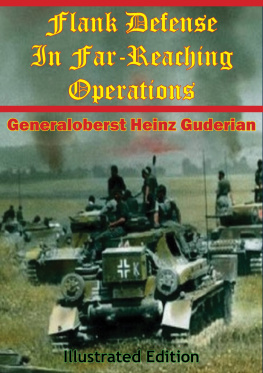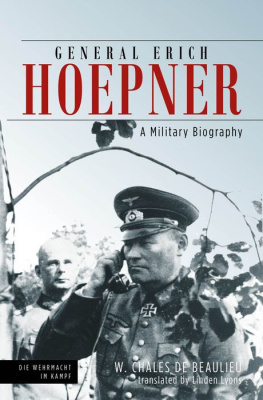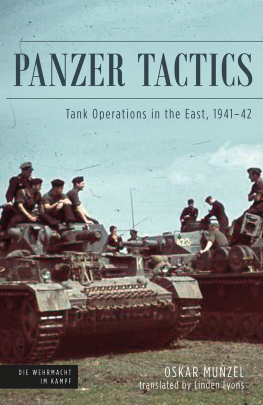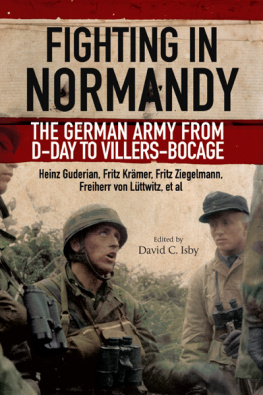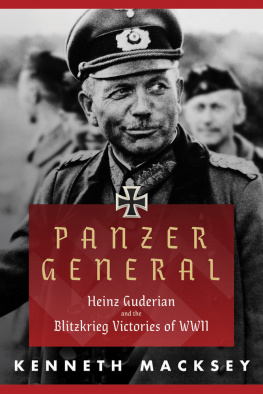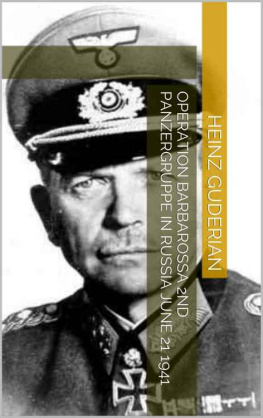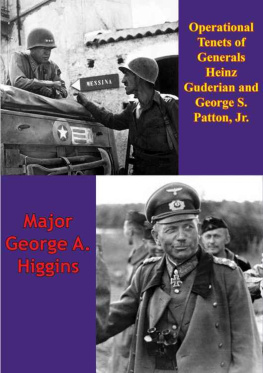

This edition is published by PICKLE PARTNERS PUBLISHINGwww.picklepartnerspublishing.com
To join our mailing list for new titles or for issues with our books picklepublishing@gmail.com
Or on Facebook
Text originally published in 1952 under the same title.
Pickle Partners Publishing 2014, all rights reserved. No part of this publication may be reproduced, stored in a retrieval system or transmitted by any means, electrical, mechanical or otherwise without the written permission of the copyright holder.
Publishers Note
Although in most cases we have retained the Authors original spelling and grammar to authentically reproduce the work of the Author and the original intent of such material, some additional notes and clarifications have been added for the modern readers benefit.
We have also made every effort to include all maps and illustrations of the original edition the limitations of formatting do not allow of including larger maps, we will upload as many of these maps as possible.
FLANK DEFENSE IN FAR-REACHING OPERATIONS
BY GENERALOBERST HEINZ GUDERIAN
TABLE OF CONTENTS
Contents
Introductory Note:
This study will chiefly be concerned with the operations of the Second Panzer Army which were commanded by the author. The theme will also be illustrated with examples from other Panzer Armies.
I. The Planned Offensive Across the Bug
In July 1941, Panzer Group 2 (since 5 OctoberSecond Panzer Army) was ordered to cross the Bug on D-Day on both sides of Brest-Litovsk, to break the Russian Front and to reach the Roslavl-Yelnya-Smolensk area in rapid exploitation of the initial success.
Panzer Group 2 was to receive new directives after reaching this objective. The Panzer Group was assigned to Army Group Center,
The CG, on the basis of experiences gained during the campaign in the West, decided to have four armored divisions spearhead the crossing of the Bug. The commander requested the cooperation of the infantry for the attack as well as for the blocking of Brest-Litovsk (XII Corps). The armored attack had to be conducted south and north of the fortress of Brest-Litovsk,
After having crossed the Bug, Panzer Group 8 had the impassable Pripet swamps to its right. Only small infantry elements of Fourth Army were to advance in this terrain.
Elements of Fourth Army attacked at the Panzer Group's left. The infantry of Ninth Army attacked subsequently.
To provide uniform command as soon as the Offensive started, the commander requested and obtained the attachment of XII Corps and of infantry divisions stationed in the zone of attack. At the same time, the Panzer Group became subordinate to Fourth Army, Field Marshal von Kluge commanding.
In the wake of the successful armored attack, open flanks on both sides would necessarily develop from the start. Those flanks had to be protected. It was chiefly the left flank which was threatened due to the heavy Russian concentration near Bialystok. This concentrated force, after recognizing the danger caused by the tanks in its rear, could be expected to attempt an escape from the threatening encirclement. The Russians might push along the main road via Volkovisk-Slonim.
The Commanding General decided to secure flank protection by two measures:
a. distribution in depth, especially on the most severely threatened left flank;
b. employment of the 1st Cavalry Division belonging to the Panzer Group on the right flank in this swamp area which was hardly passable for motorized units.
Further protection was provided by the infantry divisions following the armored divisions as well as by far-reaching air reconnaissance.
With the start of the offensive on 22 June 1941, the following units moved up:
XXIV Panzer Corps (General of the Panzer Troops, Baron Geyr von Schweppenburg) with 255th Infantry Division (subordinate for crossing the river) from Vlodava toward Maloryta; First Cavalry Division from Slavatishche via Maloryta toward Pinsk; Fourth Panzer Division from Koden toward the road Brest-Kobryn; Third Panzer Division from north of Koden toward Brest-Kobryn; Tenth Motorized (Division) behind as. second wave;
XII Corps (General Schroth) with 45th and 31st Infantry Division from the line north of Koden-Neple for the encirclement of Brest-Litovsk, with the forces not needed for this operation, in order to advance between the roads Brest-Kobryn-Bereza Kartuska and Motykaly-Pellshche-Pruzana-Slonim for mopping up the terrain between XXIV Panzer Corps and the XXXXVII Panzer Corps, adjacent to the left, to protect the inner flanks of these two Corps;
XXXXVII Panzer Corps (General of the Panzer Troops Lemelsen) with 18th and 17th Panzer Divisions in the front lines from Legi and Pratulin via the Lesna sector on both sides of Vistizhche toward Vidomla-Pruzana-Slonim, with the 29th Motorized Division behind as second wave; with the 167th Infantry Division subordinate for crossing the river to the left of the panzer divisions.
XXXXVI Panzer Corps (General of the Panzer Troops Baron von Vietinghoff) with 10th Panzer Division, SS Division "Das Reich" and Infantry Regiment "Gross Deutschland" were at first held back in the area Radzyn-Lukov-Deltlin in order to be added as reserves for the Panzer Groups to the XXXXVII Panzer Corps, following the clearing of the Bug bridges.
The crossing of the Bug succeeded at the entire front, because the surprise of the enemy was complete. South of Brest, the bridges across the river fell undamaged into the hands of XXIV Panzer Corps; northwest of Brest, the bridges had been destroyed earlier and had to be replaced by an emergency bridge at Legi.
The enemy, however, recovered quickly from his surprise and defended himself bravely in his shelters. The important citadel of Brest was held with special tenacity for several days, thus blocking the main highway, the railroad and the bridges across the Bug and the Muchaviec.
In the evening, the Panzer Group fought for Maloryta, Kobryn, Brest and Pruzana, where the 18th Panzer Division engaged its tanks for the first time.

Model and Guderian discuss details of the operation. June 1941
In the course of the following days, XXIV Panzer Corps advanced fighting with its three panzer and motorized divisionsthree panzer divisions ahead, along the highway Kobryn-Bereza Kartuska toward Slutsk, where strong resistance had to be broken by committing both panzer divisions, while the Tenth Motorized followed in reserve. The 1st Cavalry Division protected the right flank by advancing via Antopol-Drohiczyk toward Pinsk.
Russian flank attacks from the swamp region of Kowel were parried off between 23 and 26 June near Maloryta by Fourth Army's LIII Corps (enclosure I). On 24 June XXXXVII Panzer Corps reached Slonim where it fought together with the 18th Panzer Division south of Slonim, and with the 17th Panzer Division in that town and east of it against the enemy facing our front; and against constantly increasing pressure from the direction of Volkovisk. The 29th Motorized Division, from our zone of depth, was employed for flank protection against enemy forces retreating to the east. The 29th Motorized Division in the Zevlianka sector had to contend for several days with violent defense, into which the advance elements of XXXVI Panzer Corps, having moved up in the meantime, were also dragged (Panzer Regiment of the 10th Panzer Division); furthermore, parts of LIII Corps (167th and 55th Infantry Division, see special report of LIII Corps, enclosure 1), The intensity of this fighting is being exemplified by 36,000 prisoners which the 71st Infantry Regiment of the 29th Motorized Division alone captured from 26 to 30 June.
Next page
